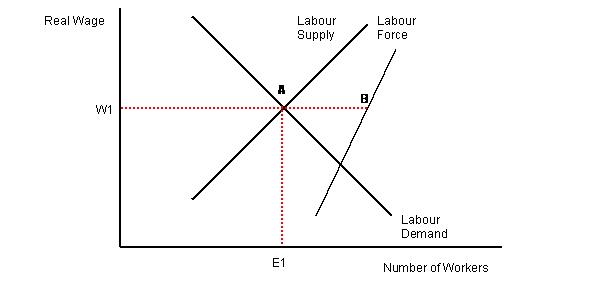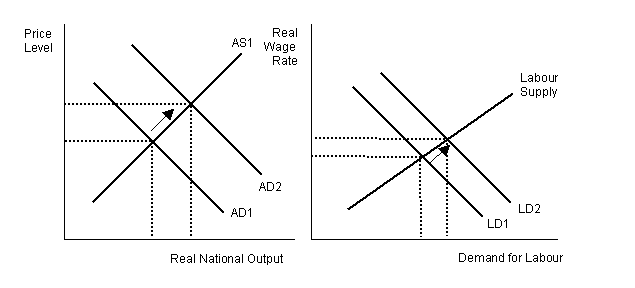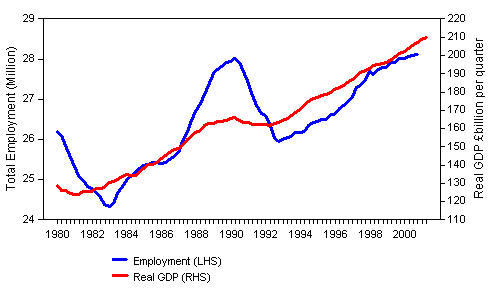Introduction
Natural rate of unemployment can simply be defined as the equilibrium rate of unemployment. This rate normally comprises both structural and frictional unemployment. The government can only slash the natural rate of unemployment by cutting the horizontal distance between the supply curve of labour and the labour force curve. There is evidenced that the supply part of labour market policy will augment the number of individuals prepared and competent to work in the labour market and this will result to a shift in SL curve to the right thus lessening the gap as explained in the diagram below.

Research indicates that generally the rate of unemployment in the UK has gone down as compared to other European nations. This phenomenon has been attributed by different economists to well maintained rate of inflation in the country which in turn has led economic growth.
Discussion
The issue of controlling aggregate demand in an economy may not sufficiently reduce the rate of unemployment, to the required level by the government. Such macro-economic policies of increasing the level of aggregate demand like lowering the interest rates or reducing taxes in an economy cannot sufficiently help in reduction of rate of unemployment that is desired by the government. Although these policies of aggregate demand can encourage foreign investor’s especially multi-national organizations and thus providing opportunities for new jobs, many economists claim that it does not fully solve the problem of unemployment.
This economists argue that the increase of demand and production in the economy does not have to achieved using labour, but instead many organizations and modern businesses may prefer to increase there productivity through utilization of advanced technologies that comes up as a result of globalization. According to various economists when the unemployment rate falls below natural rate in an economy, inflation problem may come up because there is demand for more wages by the labour. Natural rate of unemployment can easily be used to solve the problems of unemployment especially when temporary employment opportunities are provided in the economy. The natural rate of unemployment is also more beneficial than the concept of aggregate demand because the government can formulate policies that improve the human capital of labour force to enhance the chances of unemployed to get employment opportunities.
The following diagram indicates that a rise in aggregate demand will eventually lead to an increase of aggregate supply and this will result to a rise in demand for output which in turn will lead to an increase in demand for more labour at different wage rates. This scenario will result to reduction of unemployment because there will be new job opportunities.
Relationship between aggregate demand and unemployment

Government Policies
There are several efficient policies that can be used to trim down the total level of unemployment in an economy and includes the following: The first policy is to improve the employability of the accessible labour supply. This policy will give the unemployed people an opportunity to have the necessary competence and skills that are required in order to be eligible to any vacancies that are available. Economists argue that for this policy to be successful it should centre on enhancing professional mobility of labour that is workers can shift from one job to another
The other policy is to provide incentives for individuals seeking jobs which will include payment of better wages and salaries and provisions of other monetary and social benefits to the prospective labour force. Such incentives will include providing social amenities like swimming pools in the workplace and also through provision of housing, hardship and medical allowances. This policy will entail the government carrying out some important reforms regarding to tax and benefits system.
For example the labour force may be exempted from paying some taxes as well as the government broadening its tax base in order to collect more revenue that can be used in remuneration of this potential labour force. There is an argument that decreasing actual value of unemployment benefits may lead to available labour force wishing to take up new jobs. This is always because the actual value of unemployment payback will always be beneath the national minimum wage rate.
The other policy that the government can take is develop a sustained period of economic growth through long-term economic strategic plans. Such a policy will ensure overall development of economy and thus more new jobs will be formed and thus rate of unemployment going down. However, this policy is much dependant on aggregate demand being adequately high for businesses and thus they will have greater need to expand their workforce which in turn leads to creation of new employment opportunities and thus reducing the rate of an employment in the economy. It is evident that an improving economy presents an opportunity for new jobs creations because firms expand in there production processes and thus they will seek more workforce to foster their activities and thus increasing their desired profits level in their respective firms.
The following diagram illustrates the relationship between the economic growth in terms of Gross Domestic Product and the rate of unemployment. For example, the figure below indicates that the number of workforce fell significantly in the periods of 1980-1981 and 1990-1992. This is because this was two periods of economic recession in the UK. However, the graph indicates a significant increase in economic growth in the years 1993 to 2001, which has led to reduction of unemployment in the UK.
Economic Growth and Creation of Employment

The other policy that the government need to adopt is to try and provide viable ways e.g. education and training in order to improve skills of the potential workforce and also to reduce the occupational immobility. The policy should focus on building and enhancing the competency of those who are seeking for jobs. This policy too aims at reducing structural employment which always arises because of immobility of workers. This implies because of good qualification and competencies by the labour force they can be able to shift from one job to another in the economy.
There is also another policy of government subsidies that is firms will always be given incentives that will encourage them in increasing there production activities thus expanding in their sizes and hence it will lead to creation of new employment opportunities to those who are jobless. This policy is utilized by organizations who have taken there business levels of international marketing through globalization. This policy will also present an opportunity to those who are unemployed to source for jobs globally and not only in their host countries, for example UK citizens look job opportunities in other countries
Conclusion
In order to achieve reduction of natural rate of unemployment in an economy, the government has the responsibility of ensuring that relevant economic policies are put in place that will foster general economic growth and thus creation of new job opportunities. Although the policy of controlling aggregate demand should be emphasized, more weight has to be directed to formulation of adaptable and good policies that will enhance economic growth and thus reduction in the rate of unemployment Therefore we can conclude that the government has to embark on formulating long-term economic policies that favour growth and try to avoid on over relying on the concept of aggregate demand when reducing the natural or equilibrium rate of unemployment.
It is also evident the natural rate of unemployment is the extent of unemployment that is explicitly experienced in a nation while the labour market is in balance or is said to be in equilibrium. Various economists, for example Friedman equates this to what is called voluntary unemployment, because under this it is argued that all people who want to be employed have an opportunity to do so. However, to achieve this only policies that centre on supply side of the economy should be utilized. The respective government can only reduce the natural rate of unemployment through cutting the horizontal distance between the supply of labour curve and labour force curve. So the government should formulate policies that are directed to labour market that will result to rise in number of individuals who are competent and willing to work, for example through providing incentives.
References
- Auty, R. (2001): Resource Abundance and Economic Development. Oxford- Oxford University Press.
- Bean, C. (1992): Identifying the causes of British unemployment-Centre for Economic Performance Discussion Paper No 276.
- Blake, A. and Westaway, P. (1996): Credibility and the Effectiveness of Inflation Targeting Regimes-Manchester School. Vol 64.
- Buiter, W. and Miller, M. (1981): Monetary policy and International Competitiveness. Oxford Economic Papers. Vol 33.
- Buiter, W. and Miller, M. (1985): Costs and Benefits of an Anti-inflationary Policy- Inflation and Unemployment- Theory, Experience and Policy Making. London- George Allen and Unwin.
- Institute of Economic Affairs. (1973): Macro-economic Thinking and the Market Economy. An Essay on the Neglect of the Micro-Foundations and Its Consequences. London.
- Joseph T. (1999): The Place of Mises’s Human Action in the Development of Modern Economic Thought. Quarterly Journal of Economic Thought Vol. 2.
- Phillips, A. (1958): The relation between unemployment and the rate of change in Money wages in the United Kingdom. 1861 to1957Economica Vol 25.
- Tutor2u (2007): Natural rate of unemployment. Web.
- Wallis, K. Long bottom, J. Turner, D. and Whitley, J. (1987): Models of the UK.
- Economy- A Fourth Review by the ESRC Macroeconomic Modelling Bureau, Oxford University Press.
- Yates, A. (1998): Are prices and wages sticky downwards? Bank of England Quarterly Bulletin Vol 38.
